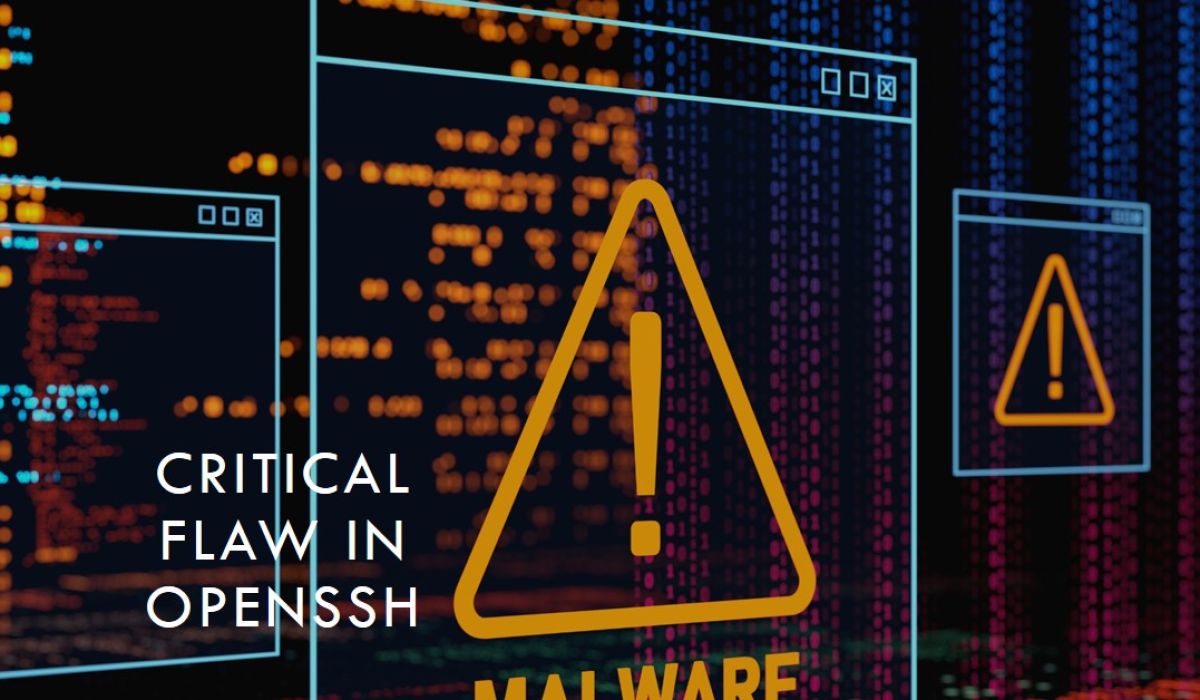The security landscape faces a worrying resurgence with the discovery of regreSSHion (CVE-2024-6387) by Qualys researchers. This critical vulnerability in the OpenSSH server allows remote attackers to potentially execute malicious code and gain full control of the system (remote code execution or RCE). What makes regreSSHion particularly concerning is its nature – a regression of a vulnerability addressed in 2006 (CVE-2006-5051). This raises questions about code quality and the potential presence of similar hidden flaws.
Furthermore, the widespread reliance on OpenSSH in cloud systems makes them prime targets for exploitation if left unpatched. Let’s delve deeper into the technical details of this vulnerability.
Under the Hood of RegreSSHion: A Race Against Time
RegreSSHion exploits a weakness in OpenSSH known as a signal handler race condition. Let’s break down the components involved:
- LoginGraceTime: This setting defines a timeout period for failed login attempts. By default, OpenSSH offers a window of 120 seconds (2 minutes) for a client to successfully authenticate before terminating the connection.
- SIGALRM Handler: When a process exceeds its allocated time limit (including LoginGraceTime for failed logins), the operating system triggers a signal known as SIGALRM. OpenSSH employs a specific handler function (SIGALRM handler) designed to react to this signal.
- Race Condition: The vulnerability lies in the actions of the SIGALRM handler. In older, secure versions of OpenSSH, a directive (#ifdef DO_LOG_SAFE_IN_SIGHAND) prevented the handler from calling functions like syslog() which can be unsafe within a signal handler context.
Unfortunately, this security measure was removed in OpenSSH versions 8.5p1 and later. This creates a vulnerability window. An attacker could launch a barrage of failed login attempts just before the timeout to trigger the SIGALRM handler. If the timing is precise, the attacker might inject malicious code during the window when the vulnerable handler calls unsafe functions, potentially leading to memory corruption and code execution.
Exploiting RegreSSHion: A Delicate Dance with Uncertainty
Successfully exploiting regreSSHion is a complex task requiring significant effort and a bit of luck due to the inherent race condition. Here’s a breakdown of the attacker’s potential strategy:
- Target Selection: Attackers would likely target systems running vulnerable OpenSSH versions (8.5p1 and later) and identify those with the default LoginGraceTime (120 seconds).
- Rapid Login Attempts: The attacker would unleash a flurry of login attempts with invalid credentials to trigger the SIGALRM handler. This requires precise timing to occur just before the timeout window closes.
- Memory Manipulation: During the narrow window when the SIGALRM handler is executing, the attacker would attempt to manipulate memory on the server. This could involve exploiting the race condition to overwrite critical data structures with malicious code.
- Code Execution Payload: If the memory manipulation is successful, the attacker would need to inject a malicious payload that leverages the corrupted data to gain unauthorized access or even root privileges.
Pseudocode Example (Illustrative – Do not attempt to reproduce):
// Attacker Script (Pseudocode)
while (true) {
// Craft invalid login attempt packet
send_login_packet(invalid_credentials);
// Wait for near timeout window
sleep(LoginGraceTime - short_delay);
// Trigger multiple attempts at once to increase exploit window
for (i = 0; i < 100; i++) {
send_login_packet(invalid_credentials);
}
}
Challenges and Complexity:
- Timing is Crucial: The success of this exploit hinges on manipulating memory within a very brief window during the SIGALRM handler execution. Even minor timing deviations can render the exploit ineffective.
- Multiple Attempts Required: Due to the unreliability of the race condition, attackers may need to launch a large number of attempts to increase the chance of successful exploitation.
- Exploit Code Development: Crafting the memory manipulation code and the malicious payload specific to the target system can be a complex task.
Securing Your Systems Against RegreSSHion
Fortunately, there are steps you can take to mitigate the risks posed by regreSSHion:
- Upgrade OpenSSH: The most effective and permanent solution is to upgrade OpenSSH to the latest patched version as soon as possible. Consult your system administrator or refer to official OpenSSH resources for specific upgrade instructions.
- Temporary Workaround (Use with Caution): If immediate patching is not feasible, a temporary workaround exists. Setting the LoginGraceTime to 0 in the OpenSSH server configuration eliminates the timeout window altogether, preventing the SIGALRM handler from triggering and effectively removing the vulnerability window. However, this approach comes with a caveat: if all connection slots become occupied due to legitimate login attempts, it can lead to a denial-of-service (DoS) situation where new connections are refused.
- Seccomp for Enhanced Defense: Consider implementing seccomp, a kernel feature that restricts system calls allowed to processes. This can act as an additional security layer, potentially hindering even a successful regreSSHion exploit from achieving its full potential.
RegreSSHion and the Cloud: Keeping Your Kubernetes Clusters Secure
While the focus so far has been on individual systems, containerized environments like Kubernetes also deserve attention regarding regreSSHion. Here’s why:
- Impact on Containerized OpenSSH: If containers within your Kubernetes cluster run OpenSSH servers, they inherit the vulnerability if not addressed. This can potentially grant attackers a foothold within the cluster itself.
Risk Mitigation Strategies for Kubernetes Users:
- Strict Seccomp Profiles: Kubernetes allows deploying pods with seccomp profiles that restrict system calls available to container processes. This can significantly limit the potential damage even if an exploit is successful.
- Network Policy Enforcement: Network policies within Kubernetes can be configured to restrict access to SSH ports on cluster nodes. This minimizes the attack surface by only allowing authorized sources to connect to SSH services.
- Regular Updates are Key: Maintaining up-to-date container images and the Kubernetes environment itself is crucial. Patching promptly ensures vulnerabilities like regreSSHion are addressed swiftly.
- Strong Authentication is a Must: Don’t rely solely on passwords for SSH access. Implement multi-factor authentication or public key authentication to add extra layers of security.
By implementing these strategies, Kubernetes users can significantly reduce the risk posed by regreSSHion and bolster the overall security posture of their containerized environments.
Vulnerability Management: Proactive Defense for Kubernetes
RegreSSHion highlights the importance of proactive vulnerability management in Kubernetes environments. Here, powerful tools can aid in the process:
- ARMO Platform and Kubescape: These tools offer comprehensive vulnerability scanning and management capabilities specifically designed for Kubernetes clusters. They can identify vulnerabilities within container images, pod configurations, and the underlying Kubernetes infrastructure itself.
- Exploit Prediction Scoring System (EPSS): EPSS goes beyond simply detecting vulnerabilities. It assigns a score based on the likelihood of a specific vulnerability being exploited in the real world. This prioritization helps security teams focus their efforts on the most critical threats.
Benefits of Vulnerability Management Tools:
- Proactive Notification: These tools can be configured to send automated alerts when new vulnerabilities are discovered within the cluster. This enables prompt action before attackers can exploit them.
- Filtering and Prioritization: With features like EPSS scoring, you can filter vulnerabilities based on their severity and exploitability. This allows security teams to focus on the most pressing issues and optimize their remediation efforts.
Vigilance is Key in the Fight Against RegreSSHion
The regreSSHion vulnerability (CVE-2024-6387) serves as a stark reminder that even well-established software like OpenSSH can harbor unforeseen flaws. This critical remote code execution (RCE) vulnerability highlights the importance of continuous vigilance in cybersecurity.
System administrators must take action to mitigate the risks posed by regreSSHion:
- Prioritize patching: Upgrade OpenSSH to the latest patched version as soon as possible.
- Temporary workarounds: If immediate patching is not feasible, consider cautiously setting LoginGraceTime to 0 as a temporary measure.
- Seccomp for additional defense: Implement seccomp to restrict system calls and limit potential damage from a successful exploit.
For Kubernetes users:
- Enforce strict seccomp profiles and network policies to minimize attack surfaces within your cluster.
- Maintain regular updates for Kubernetes, container images, and underlying infrastructure.
- Implement strong authentication mechanisms beyond simple passwords.
Proactive vulnerability management is essential. Consider utilizing tools like ARMO Platform, Kubescape, and EPSS to identify, prioritize, and address vulnerabilities effectively.
By staying informed, applying security best practices, and adopting a proactive approach, we can collectively enhance our cybersecurity resilience and mitigate the threats posed by vulnerabilities like regreSSHion.
Call to Action
Subscribe to our blog for regular updates on cybersecurity news and the latest vulnerability alerts. Follow us for more insights and best practices to strengthen your cybersecurity posture in the cyber world.





